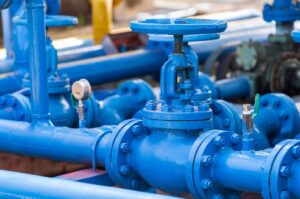Gazprom is putting a brave face again and announcing new completion dates for Nord Stream 2. Just like before, the new deadlines are just propaganda. However, it is possible for Russia to finish the project on its own. One of the solutions is the Akademik Chersky vessel that will soon reach the Baltic Sea – writes Mariusz Marszałkowski, editor at BiznesAlert.pl.
Change of plans
The construction of Nord Stream 2 was halted in late December last year when Allseas left the project fearing US sanctions. Since then, gravel and stones are being placed on the existing pipeline, but no other work is conducted. Contrary to the physical laying of pipes on the seabed, this kind of work has not been sanctioned by lawmakers in the National Defence Authorization Act, i.e. the Pentagon’s budget bill. The goal of the sanctions is to make it impossible for Gazprom to lay pipes „at depths 100 feet or more below the sea level” (NDAA, 2019).
Currently Russia owns three vessels that could theoretically continue the construction of the pipeline, those include two pipelaying barges Fortuna and Defender owned by a company called MRTS and a ship Akademik Chersky owned by Gazprom Flot.
Barges for Nord Stream 2?
The 170-meters long Fortuna barge was constructed in 2010 in Shanghai and has been sitting at Germany’s Mukran harbor since October 2019. The port is also one of Nord Stream’s logistics hubs. Originally the barge was to complete two tasks for the NS2 project. The first one was to lay both pipes in the nearshore waters of the Russian section. The second one was to complete above-water tie-ins in the German exclusive economic zone (EEZ) to connect it with the pipes in Denmark’s EEZ.
The fact that in the course of the project the vessels are used for a different purpose than originally intended is not surprising. For instance, according to the original plans the Solitaire was to construct 728 km of both lines in the Gulf of Finland. However, in reality it also worked in the Swedish and Danish zones.
Defender instead of Fortuna?
The 135 meters long Defender barge was launched at China’s Longchuan shipyard in 2006. Its current location is unknown. Previously the barge laid pipes for the 4-line Bovanenkovo – Ukhta gas pipeline. Two out of the four lines surfaced due to gas pressure and insufficient protection against the elements on the seabed. The incident posed a threat to the environment in the Baydarata Bay. It is unknown how it impacted gas transfer via the pipeline.
Fortuna and Defender can lay pipes with a diameter of up to 60 inches, including concrete coating. This is enough to lay the 48-inch wide Nord Stream 2. Both ships include six welding stations, one testing station and 2 NDT and 2 insulation coating stations. It is estimated that the average pace of laying the NS2 pipes is 1.5 km a day.
A problem with Denmark
The Danish permission to construct the pipeline south of the Bornholm Island says that the pipe-laying needs to be conducted by a dynamically-positioned vessel. This system allows the ship to stay still on the sea without the necessity to use anchors. Neither of the Russian barges has the DP system, or their own motor. This means both need anchor handling tug vessels (AHTV) to perform work, we wrote about the AHTV extensively here. Denmark wants Gazprom to use the DP system because it is afraid that without it, the pipe-laying ships will lift WW 2-era chemical weapons and ammunition from the seabed. The Bornholm Basin was the main drop point for these weapons.
In January Gazprom announced it planned to ask the Danish Energy Agency to update its permit to allow anchored vessels, such as the Defender and Fortuna, to work on the pipeline. At the end of the month the Agency’s spokesman Ture Falbe-Hansen, said that the company had not submitted an official application to change the permit and added that if the request was actually made the Agency would consider it.
It is possible the Agency will agree to the use of anchored vessels. Over 70% of the first Nord Stream pipeline was completed by such ships. During that project the Danish section of the pipe was constructed by Italy’s Saipem’s Castoro Sei ship.
Is the Akademik Chersky heading to the Baltic?
The third solution is to use the Akademik Chersky vessel. The ship, whose previous name was Jacson 18, was constructed in two stages. The first one was completed in 2007 at China’s Tongzhou shipyard, the second at Singapore’s Kwong-Soon shipyard. In December 2015 Jackson 18’s first owner, a Nigerian-Dutch company STG, sold the ship to Russia’s Mezhregiontruboprovodstroy (MRTS). The purchase was bankrolled by Gazprombank with a billion dollar guarantee. In 2016 it was taken over by Gazprom Flot and the purchase was motivated by the fact that in 2014 the US introduced sanctions against Gazprom, which impacted the Yuzhno-Kirinskoye gas field. The sanctions prevented western companies from taking part in developing the field. That’s when the name of the vessel was changed to commemorate the Soviet academic Nikolai Chersky.
Until the 2019 US sanctions were introduced, it seemed the ship would continue to support Gazprom’s Far East projects.
At the end of December 2019, Gazprom Flot announced a tender for equipping the ship with welding equipment worth 870 million roubles. The original plan said the results of the bid would be announced on 22 January 2020, but in the end the winner of the tender was announced on 10 February, but the company’s name was not revealed. Rumor has it that the deadline was moved because a third firm placed its bid (one that had not previously intended to take part in the tender) and in the end won.
The Chersky left the Nakhodka port on the same day. It had stayed there since October 2019. Initially it was heading to Singapore, which it was supposed to have reached on 22 February. It was speculated that perhaps the modernization would take place there. The gossip was fuelled by the fact that Singapore conducted the second stage of the ship’s construction. However, in the end the Chersky did not go to Singapore and instead has continued to head West. The next „end” harbor in the AIS system is the Port of Colombo in Sri Lanka. Yet, it looks like this is not the ship’s final destination.
It seems the goal of these tactics is to keep others, including Americans, in the dark about the ship’s target harbor. Gazprom is afraid the US could introduce sanctions against the ship before it enters the Baltic. Neither Gazprom nor Nord Stream 2 AG want to answer questions about the destination of the ship.
Tenders reveal the truth
Gazprombank’s Electronic Trading Platform is used by Gazprom to announce tenders, so the information in the portal can be used to determine where the Chersky is actually going.
In mid January a few tenders pertaining to the ship appeared on the platform. The procurement orders included pumps, compressors and other supplies such as tees, seals and IMO approved information boards. They all have one thing in common – they need to be delivered to the port in Kaliningrad or St. Petersburg.
It is possible that the company that won the tender on 10 February is located in one of Russia’s harbors on the Baltic. If nothing unexpected occurs, the Akademik Chersky should reach the sea at the beginning of April. At that point it will be renovated in either Kaliningrad or St. Petersburg to be able to lay the Nord Stream 2 pipes.
Akademik Chersky’s challenges
Russia’s inexperience in managing such large and complicated projects as Nord Stream 2 is an issue. Apart from the pipe-laying, the other challenge is logistics – the ability to ship pipes, supplies and fuel to the vessels that do the laying. Gazprom needs to lay 160 km of pipes to complete the project. Even though it does not seem like a lot, with only one ship available it will take at least three months.
It is estimated that the Chersky is able to lay 2-2.5 km of pipes a day, whereas the Allseas ships were able to lay 5 km in case of the Solitaire and about 7 in case of the Pioneering Spirit.
Another issue that the project has to tackle is the possible US sanctions against Gazprom Flot’s and MRTS’s vessels. If imposed it will be more than likely that no foreign company will agree to work on the project, e.g. PSV’s ships will not be chartered to transport pipes, no insurance company will agree to insure the ships working on the Baltic and no company will want to transport the employees. To exchange the Allseas crews helicopters were used 3 times a week. Such limitations will make it impossible for any Russian ship to complete Nord Stream 2.
On paper Gazprom is able to finish the construction on its own. In practice it will be difficult and expensive with no guarantee of success. Additionally, the fleet itself is very unimpressive. The Chersky is believed to be rundown, so its voyage from Asia to Europe may pose a huge challenge in itself. Another issue is the Russian work ethic and adherence to health and safety rules. When the works were conducted by specialized, Western companies the risk of an incident was very low. However, the quality of work done by Russian companies above the polar circle does not provide much scope for optimism, especially among those concerned about the Baltic Sea’s ecosystem.
Additionally, engaging all of Gazprom’s resources in the Baltic will impact its projects in the Far East. Therefore, it may have an adverse effect on the company’s hyped up pivot to Asia. Yet again, Gazprom has proven that Nord Stream 2 has little to do with doing actual business. Now the company needs to save its face and a few billion Euros currently drowning in the Baltic depths.








